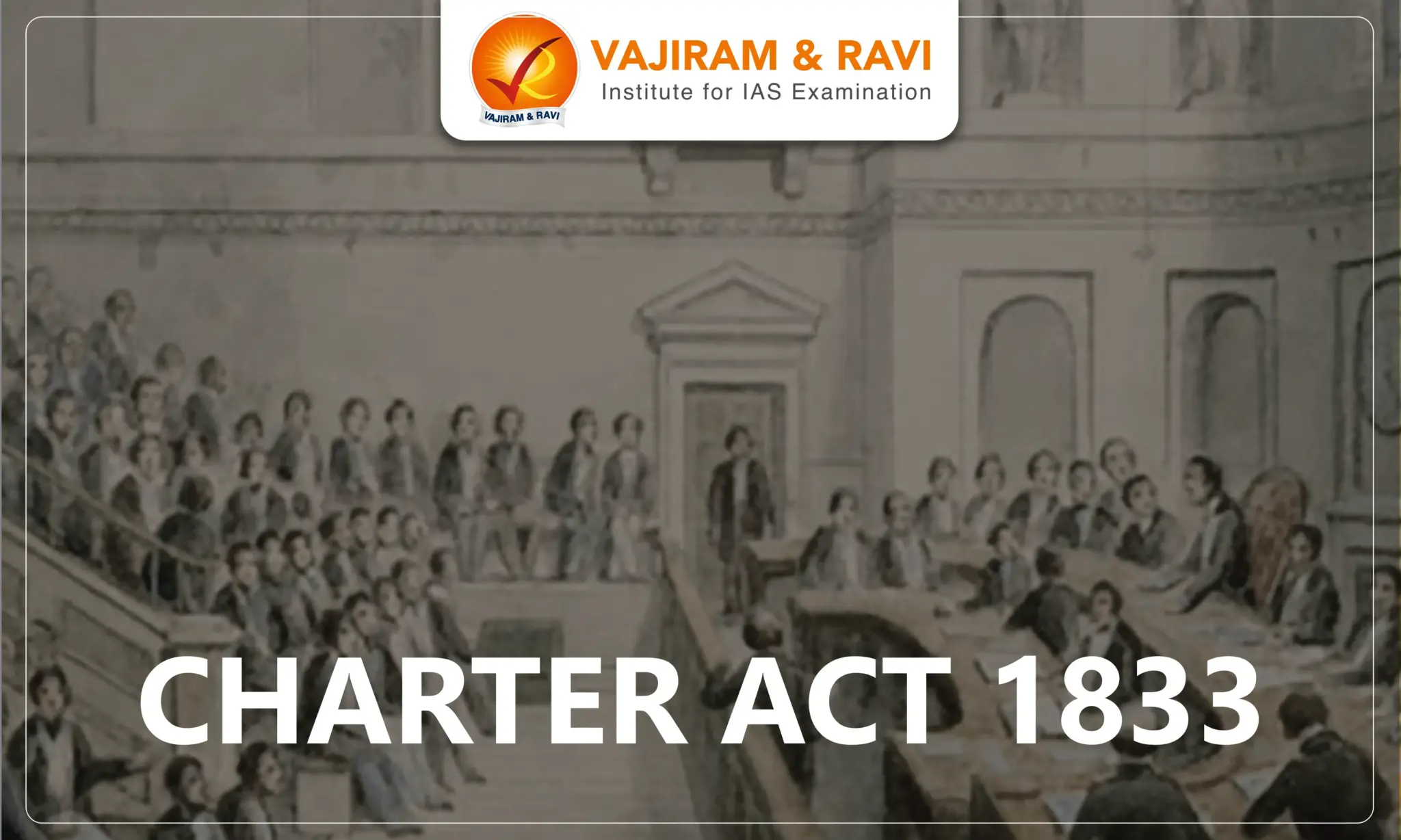The Charter Act of 1833, also known as the Saint Helena Act, was a major piece of British legislation. It was a significant reform that marked a watershed moment in British India’s administration. The Act aimed to consolidate and streamline governance in British territories in India, reshaping the administrative and legal framework.
Charter Act 1833 Background
The British East India Company was initially granted a monopoly over trade and governance in the Indian subcontinent. However, by the early nineteenth century, concerns about corruption, inefficiency, and the need for reform prompted the passage of several Acts, including the Charter Act of 1833.
- Before the Charter Act, the East India Company underwent several reforms, including the Regulating Act of 1773 and the Pitts India Act of 1784.
- These Acts were intended to address administrative issues and increase control over the company’s operations.
- The Charter Act of 1833 was introduced to continue this process, providing a more comprehensive framework for governance.
Charter Act 1833 Features
The Charter Act of 1833 centralized British governance in India by extending the East India Company’s lease and empowering the Governor-General, while lifting trade monopolies and facilitating European colonization. It also prohibited discrimination against Indians and initiated reforms to improve slavery conditions, leading to its abolition in 1843.
- The Company’s 20-year lease was extended. The Crown would govern India’s territories, and the Company’s monopoly on trade with China and tea was lifted.
- The restrictions on European immigration and property acquisition in India have been lifted. This paved the way for extensive European colonisation of India.
- The Charter Act, 1833 centralised administrative power by establishing a single governing body for British India. The administrative powers of the East India Company were transferred to a new position known as the Governor-General of India.
- The governor-general was appointed to oversee and direct the Company’s civil and military affairs.
- The governor-general assumed complete control over Bengal, Madras, Bombay, and other territories.
- The governor-general would control all revenues and expenditures.
- The Governments of Madras and Bombay lost their legislative powers and were only able to propose law projects to the Governor-General.
- A law expert was appointed to the governor-general’s council to provide professional advice on legislation.
- The Company prohibits discrimination against Indian citizens based on religion, colour, birthplace, or descent. Although the reality differed, this declaration served as the foundation for political activism in India.
- The administration was urged to improve slavery conditions and eventually abolish it. (Slavery was abolished in 1843).
Charter Act 1833 Significance
The Charter Act of 1833 abolished the East India Company’s trade monopoly, transitioning it into an administrative body for the British Crown and centralizing power under the Governor-General of India. It also initiated legal codification, promoted merit-based inclusion of Indians in government, and streamlined legislative authority.
- End of Trade Monopoly: The Act abolished the East India Company’s trade monopoly in India, allowing free trade and competition to flourish. This marked the Company’s transition from a commercial entity to an administrative body acting for the British Crown.
- Centralisation of Administration: By elevating the Governor-General of Bengal to the Governor-General of India, the Act consolidated power and established a more unified governance structure throughout British India.
- Codification of Laws: It resulted in the establishment of the Indian Law Commission, led by Lord Macaulay, which was instrumental in codifying Indian laws and laying the groundwork for a more structured legal framework.
- Social and Administrative Reforms: The Act established provisions for the inclusion of Indians in government services based on merit, removing racial, religious, and caste barriers and promoting a more inclusive administrative system.
- Legislative Powers: It centralised legislative authority in the hands of the Governor-General in Council, ushering in a more structured legislative process in India.
Charter Act 1833 Limitations
The Charter Act of 1833 led to the over-centralization of power in the Governor-General, weakening governance in distant presidencies while failing to provide adequate local representation or clarify judicial powers. Though it allowed Indian participation in government, British officials largely dominated the administration.
- Over-centralization: The Act resulted in an over-concentration of power in the hands of the Governor-General, which occasionally hampered effective governance and decision-making, particularly in distant presidencies such as Madras and Bombay.
- Lack of Representation: The Act failed to provide adequate representation for the Madras and Bombay presidencies in the central legislative council, resulting in a disconnect between local and central government.
- Judicial Ambiguities: While the Act intended to codify laws, it failed to clearly define the jurisdiction and powers of the newly established courts, resulting in legal ambiguities and conflicts.
- Limited Impact on Indian Participation: Although the Act provided Indians with access to government services, significant barriers remained in practice, and British officials dominated the administration.
The Charter Act of 1833 was a pivotal legislative measure that redefined the administrative structure of British India. It terminated the commercial functions of the East India Company and introduced comprehensive administrative and legal reforms aimed at centralizing governance and enhancing administrative efficiency. However, the Act had notable shortcomings, especially in terms of limiting Indian participation in governance and failing to address broader political rights. Despite these limitations, it laid the foundation for subsequent reforms and significantly impacted the evolution of British administrative policies in India.
Charter Act 1833 PYQs
Question: By which one of the following Acts was the Governor General of Bengal designated as the Governor General of India? (UPSC Prelims 2023)
(a) The Regulating Act
(b) The Pitt’s India Act
(c) The Charter Act of 1793
(d) The Charter Act of 1833
Answer: (d)
Last updated on April, 2025
→ UPSC Notification 2025 was released on 22nd January 2025.
→ UPSC Calendar 2026 is released on 15th May, 2025.
→ The UPSC Vacancy 2025 were released 1129, out of which 979 were for UPSC CSE and remaining 150 are for UPSC IFoS.
→ UPSC Admit Card 2025 is released now for CSE Prelims Exam 2025.
→ The UPSC Prelims 2025 is scheduled to be conducted on 25th May 2025 and UPSC Mains 2025 will be conducted on 22nd August 2025.
→ Apply once through it and aspirants can apply for various government exams conducted by UPSC.
→ The UPSC Selection Process is of 3 stages-Prelims, Mains and Interview.
→ UPSC Result 2024 is released with latest UPSC Marksheet 2024. Check Now!
→ UPSC Toppers List 2024 is released now. Shakti Dubey is UPSC AIR 1 2024 Topper.
→ Also check Best IAS Coaching in Delhi
Charter Act 1833 FAQs
Q1. What was the Charter Act of 1833?+
Q2. What was the main aim of the Charter Act?+
Q3. What is the first Charter Act of India?+
Q4. Who was the Governor-General in 1833?+
Q5. What was the Law Commission of India in 1833?+

















